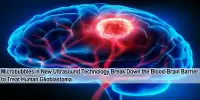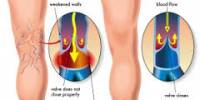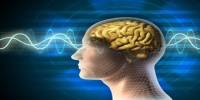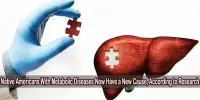Mastocytosis
Definition: Mastocytosis, a type of mast cell disease, that occurs when too many mast cells accumulate in the skin and/or internal organs such as the liver, spleen, bone marrow, and small intestines. It is a rare disorder affecting both children and adults caused by the accumulation of functionally defective mast cells (also called mastocytes) and CD34+ mast cell precursors.
The signs and symptoms vary based on which part(s) of the body are affected. There are two main types of mastocytosis:
- cutaneous mastocytosis, which mainly affects children – where mast cells gather in the skin but aren’t found in large numbers elsewhere in the body
- systemic mastocytosis, which mainly affects adults – where mast cells gather in body tissues, such as the skin, internal organs, and bones
Several types of systemic mastocytosis (mas-to-sy-TOE-sis) exist. The most common form — indolent systemic mastocytosis — progresses slowly. Mast cell leukemia and mast cell sarcoma are extremely rare forms of systemic mastocytosis. Treatment is based on the signs and symptoms present in each person.

Causes, Signs, and Symptoms of Mastocytosis: Most cases of mastocytosis are caused by a change (known as variation or mutation) in the KIT gene. This gene provides instructions to the body to make a protein that helps control many important cellular processes such as cell growth and division, survival, and movement. This protein is also important for the development of certain types of cells, including mast cells.
The KIT mutation makes the mast cells more sensitive to the effects of a signaling protein called stem cell factor (SCF). SCF plays an important role in stimulating the production and survival of certain cells, such as blood cells and mast cells, inside the bone marrow.
Mastocytosis can rarely affect more than one family member. In some of these cases, the condition is inherited in an autosomal dominant manner. A person with familial mastocytosis has a 50% chance with each pregnancy of passing along the altered gene to his or her child.
The signs and symptoms of mastocytosis vary based on which parts of the body are affected. Signs and symptoms of mastocytosis are more likely to occur after a “trigger” such as a change in temperature, certain medications, emotional stress, or irritation of the skin. The symptoms of mastocytosis often are similar to the symptoms of an allergic reaction.
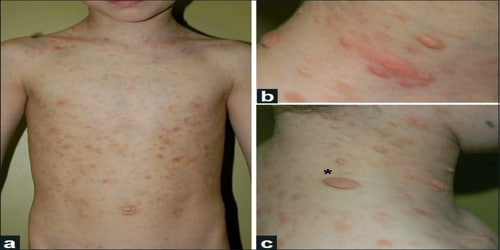
They may include, but are not limited to –
- Fatigue
- Skin lesions (urticaria pigmentosa), itching, and dermatographic urticaria (skin writing)
- Abdominal discomfort
- Nausea and vomiting
- Diarrhea
- Olfactive intolerance
- Ear/nose/throat inflammation
- Anaphylaxis (shock from allergic or immune causes)
- Episodes of very low blood pressure (including shock) and faintness
- Bone or muscle pain
- Decreased bone density or increased bone density (osteoporosis or osteosclerosis)
- A headache
- Depression
- Ocular discomfort
- Increased stomach acid production causing peptic ulcers (increased stimulation of enterochromaffin cell and direct histamine stimulation on parietal cell)
- Malabsorption (due to inactivation of pancreatic enzymes by increased acid)
- Hepatosplenomegaly
Many people affected by mastocytosis, especially systemic mastocytosis, also have symptoms of anxiety and depression. It is unknown if this is due to the stress of having these symptoms as part of daily life, or if the accumulation of mast cells may also affect the chemicals in a person’s brain, causing anxiety and depression.
Diagnosis and Treatment of Mastocytosis: Diagnosis of urticaria pigmentosa (cutaneous mastocytosis, see above) can often be done by seeing the characteristic lesions that are dark-brown and fixed. A small skin sample (biopsy) may help confirm the diagnosis.
Five tests are commonly used to look for systemic mastocytosis. They are:
- blood tests – including a full blood count (FBC) and measuring blood tryptase levels
- an ultrasound scan to look for enlargement of the liver and spleen if it seems likely
- a DEXA scan to measure bone density
- a bone marrow biopsy test – where a local anesthetic is used and a long needle is inserted through the skin into the one underneath, usually in the pelvis

Additional tests may be ordered to rule out other diseases that may cause similar symptoms, such as anaphylaxis, pheochromocytoma, carcinoid syndrome, or Zollinger-Ellison syndrome.
There is currently no cure for mastocytosis, but there are a number of medicines to help treat the symptoms. The medication(s) listed below have been approved by the Food and Drug Administration (FDA) as orphan products for the treatment of this condition.
- Cromolyn sodium (Brand name: Gastrocrom® (oral)) – Manufactured by Azur Pharma FDA-approved indication: Treatment of mastocytosis.
- Midostaurin (Brand name: Rydapt®) – Manufactured by Novartis Oncology FDA-approved indication: Treatment of adult patients with aggressive systemic mastocytosis (ASM), systemic mastocytosis with an associated hematological neoplasm (SM-AHN), or mast cell leukemia (MCL).
Treatment for symptoms that affect the skin include antihistamines and oral psoralen plus UVA (PUVA) therapy. If the symptoms are not responsive to other treatment, a doctor may prescribe steroid creams, ointments, or solutions to be applied to the skin (topical corticosteroids treatment). Proton pump inhibitors can be used to treat gastrointestinal symptoms and bone pain.
Many specialists recommended that people with mastocytosis have injectable epinephrine that they can use in case of anaphylactic shock. Other recommendations include trying to avoid known triggers of symptoms of mastocytosis.
Allogeneic stem cell transplantation has been used in rare cases with aggressive systemic mastocytosis in patients deemed to be fit for the procedure.
Information Source:

